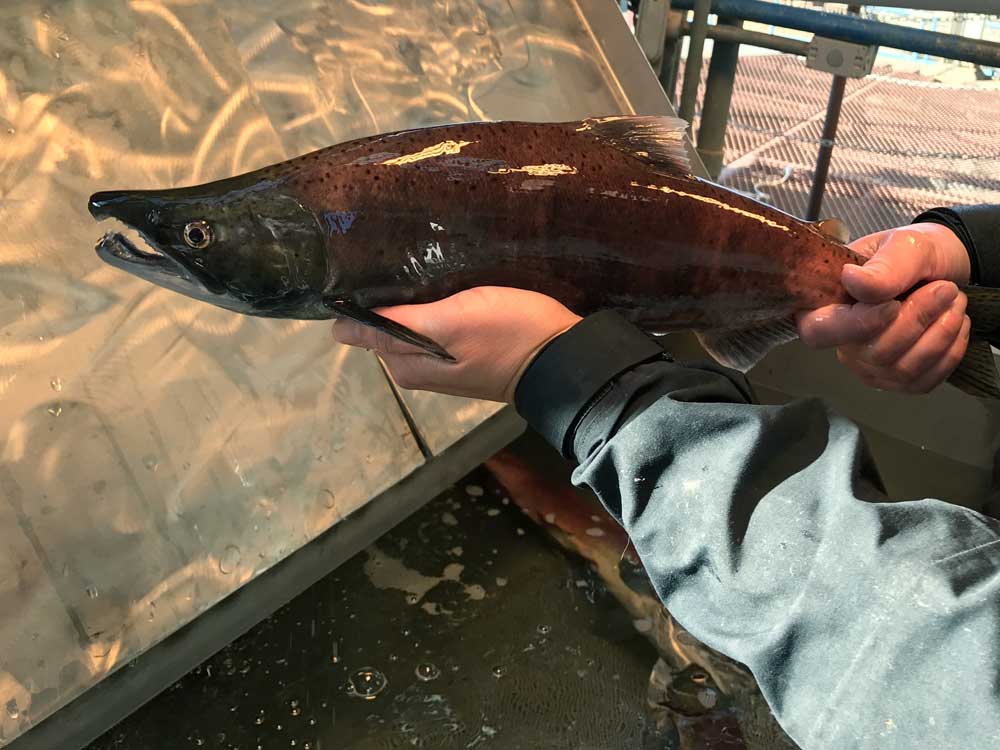Sockeye salmon return to Deschutes in droves
Published 11:56 pm Wednesday, February 1, 2017

- A biologist handles an adult sockeye salmon. (Portland General Electric/Submitted photo)
A complex of dams along the Deschutes River saw a massive return of native sockeye salmon in 2016.
A total of 536 sockeye salmon returned to the Pelton Round Butte Hydroelectric Project, a complex of three hydroelectric dams and reservoirs that stretch about 20 miles along the Deschutes River just west of Madras.
The numbers are well above previous annual returns of 19 to 86 fish since 2010.
More than 93 percent of the sockeye originated from the Middle Deschutes basin, according to laboratory results from genetic testing received by Portland General Electric in January. Of that, 92 percent were from Lake Billy Chinook, created by the Round Butte Dam.
The majority of native sockeye were able to spawn upstream of the dam complex, a positive sign for reintroduction efforts.
The dam complex co-owners — Portland General Electric and the Confederated Tribes of Warm Springs — are excited about the results but are not quite declaring it a victory.
PGE spokesman Steven Corson said it is important to remember reintroduction efforts are still in the early stages, and salmon returns are often unpredictable due to the uncertainty of a salmon migration to the ocean and back to the river.
Still, the co-owners would love to see a similar return this year, Corson said.
“We are not pointing to this and saying mission accomplished, but at the same time it’s a really great result for 2016,” Corson said. “Our goal is to have sustained and harvestable fish runs, but we are still in the beginning stages.”
In 2010, PGE and the Warm Springs tribes began operating a 273-foot, $100 million underwater tower and fish-collection facility at the Round Butte Dam. The new system made it possible for the sockeye and other species to pass through the dam and spawn upstream, after salmon runs were halted at the complex decades ago.
The underwater tower mixes warmer water from the surface and colder water from the bottom of Lake Billy Chinook, which attracts fish into the fish-collection facility through ramps. The water is sent through the dam to power turbines that generate electricity.
The dam complex was originally designed to include fish passages in the 1950s and 1960s, but the passages were not effective. As a result, fish were raised in hatcheries for decades.
During a relicensing process with the Federal Energy Regulatory Commission in the early 2000s, PGE and the tribes worked with partner state, federal and local agencies and conservation organizations to address fish passage and water quality. They agreed to a plan to create the fish passage at Round Butte Dam. FERC issued the new license in 2005.
Along with re-establishing sockeye salmon, reintroduction efforts include spring chinook and steelhead, which are hatchery raised.
Overall, more than 1,200 adult fish have been released in the Deschutes River in the past five years.
Unlike spring chinook and steelhead, sockeye have historically been living in the Middle Deschutes, making them landlocked kokanee rather than sea-going sockeye. They did not have the chance to migrate until the underwater tower made it possible.
The sockeye are now following their natural instinct to leave the river and return to spawn.
Oregon Department of Fish and Wildlife officials allowed PGE to pass 463 of the 536 returning sockeye upstream to spawn in the Metolius basin. Sockeye were seen last year on spawning grounds in the Metolius River near Camp Sherman and in tributaries of the Metolius, including Abbot Creek, Jefferson Creek, Spring Creek and Heising Springs.
While waiting for this year’s returns, biologists are busy monitoring the water quality and working on habitat-improvement projects around the Deschutes Basin.
“It’s an ongoing, scientific-based effort to maximize the potential for a successful year,” Corson said.
— Reporter: 541-617-7820,
kspurr@bendbulletin.com
“We are not pointing to this and saying mission accomplished, but at the same time it’s a really great result for 2016.”— Steven Corson, Portland General Electric spokesman






